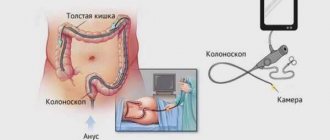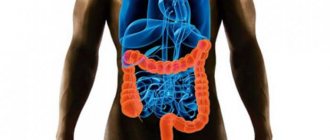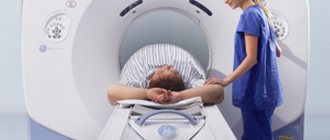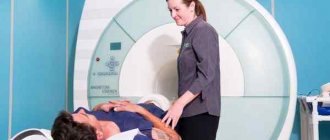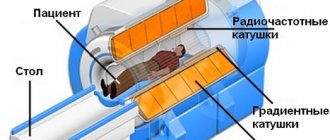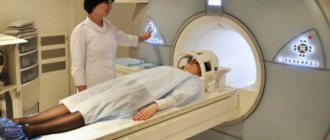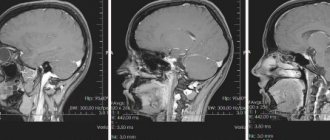Duration of colonoscopy
Colonoscopy is a diagnostic examination of the rectum and large intestine using a special device - a colonoscope. The procedure is quite complex and requires lengthy training and highly qualified doctors. To understand how long a colonoscopy can take, you need to understand the technology behind it.
The essence of diagnosis
A colonoscope is a long flexible tube (up to 145 cm). It is equipped with LED lighting, a camera and holes for introducing additional instruments - a coagulator, forceps.
The probe is also equipped with a special air supply device. It is necessary for the intestines to smooth out. This makes it easier to pass the device.
Colonoscopy allows images of the intestines to be transmitted to a monitor. With its help, you can identify even the slightest abnormalities, perform a biopsy, remove small formations and cauterize bleeding ulcers and erosions.
Possibilities
Colonoscopy of the intestine can detect:
- Cancer, even at the cellular level.
- Erosion and ulceration.
- Atypical ulcerative colitis.
- Intestinal tuberculosis.
- Crohn's disease.
- Polyps, diverticula, hemorrhoids, tumors, foreign objects.
- Pathological deviations of the intestinal mucosa, impaired motility, the presence of inflammatory processes.
Indications
Indications for diagnostics are various pathological abnormalities in the functioning of the organ and suspicions of them. A colonoscopy is performed when:
- Chronic constipation or diarrhea.
- Impurities in the stool: mucus, pus, blood.
- Pain in the abdominal area.
- Formations detected by other examination methods.
- Suspicion of cancer, intestinal obstruction, Crohn's disease, ulcerative colitis.
- Sudden, unreasonable weight loss.
- Anemia - to avoid bleeding and ulcers.
Intestinal colonoscopy is also recommended to be performed once every few years for patients who have reached the age of 50 and if there is a history of cancer in relatives.
Contraindications
Colonoscopy is not always possible. There are a number of situations when the procedure is prohibited:
- Heart or pulmonary failure.
- Inflammatory processes in the intestines.
- Poor blood clotting.
- Exacerbation of ulcerative colitis.
- Periodontitis.
- Acute infectious diseases.
- Diverticulitis.
- Extensive intestinal bleeding.
Colonoscopy is also not recommended for patients under 14 years of age and pregnant women.
Preparation
The duration of a colonoscopy includes preparation. This is the longest stage. It consists of a complete cleansing of the intestines.
Before the procedure, the patient is prescribed:
- Three-day slag-free diet. It is prohibited to consume foods that cause gas formation. The diet includes light, dietary soups, fish, dairy products, and juices. The last meal should be no later than lunch on the eve of the study.
- Enemas. They are recommended if the person being examined can use them to thoroughly cleanse the intestines. If not, laxatives are prescribed.
- Taking laxative medications. The most commonly prescribed drug is Fortrans. For 20 kg of weight you need to drink 1 sachet of medicine diluted in a liter of water. The last appointment is no later than 4 hours before the procedure.
The intestines must be completely cleansed along their entire length. If this is not done, the colonoscopy will have to be postponed and all preparatory steps will have to be repeated.
How is a colonoscopy performed?
A colonoscopy of the intestine is performed by a coloproctologist. It is carried out in several stages:
- The subject is placed on the couch in the fetal position. He should lie on his left side, with his left leg straight and his right leg bent.
- The tip of the probe is inserted into the anus with careful circular movements.
- The doctor carefully moves the colonoscope through the colon. At the same time, it delivers a stream of air to smooth out the mucous membrane, and the nurse can apply pressure to the patient's abdomen to guide the tube.
- If small formations were discovered during diagnosis, they are removed immediately using forceps, and the bleeding is cauterized.
- If necessary, a biopsy is done during a colonoscopy.
The examination is always associated with discomfort. Therefore, it is advisable not to do a colonoscopy without anesthesia and to use one of the types of anesthesia: local, general or sedation. Full anesthesia may take the longest.
How long does a colonoscopy take?
How long a bowel examination will take depends on several factors:
- Qualifications and experience of the doctor.
- Quality and modernity of diagnostic equipment.
- The structure of the intestine of a particular patient: how curved it is.
- Presence of neoplasms, bleeding, ulcerations.
- The need to carry out other procedures: biopsy, cauterization, microsurgery.
On average, a colonoscopy takes 15 to 20 minutes. Its duration may vary. If intestinal permeability is good, no pathologies are found, the period is reduced to 10 minutes. If deviations are present or additional manipulations are necessary, the time is increased to 40–60 minutes.
Post-examination period
After a colonoscopy, it is recommended to remain in bed for several hours. It is better to lie on your stomach - this will make it easier for the remaining air to leave the intestines. There are no dietary restrictions. The patient is allowed to eat any food.
Sometimes the doctor may ask you not to drink or eat for several hours. This recommendation is given in cases where microsurgery was performed on the intestines.
Colonoscopy is generally a safe procedure. Only sometimes (in 1% of all cases) complications may occur :
- Perforation of the intestinal walls. Usually occurs in the presence of purulent processes or ulceration of the mucous membrane. In this case, the doctor performs surgery and repairs the damage.
- Bleeding. Possibly after removal of polyps and other formations. Eliminates immediately.
- Abdominal pain. Appears after a biopsy or removal of tumors. Analgesics are indicated.
Colonoscopy is the most accurate and informative method of examining the intestines. It allows you to detect most pathologies at the initial stage of development. Its duration depends on the physiological characteristics of the patient, the need for other manipulations, the quality of the equipment and the experience of the doctor.
Source: https://ZHKTrakt.ru/issledovaniya/prodolzhitelnost-kolonoskopii.html
How long will a colonoscopy take?
Colonoscopy is an informative endoscopic examination of the large intestine. Many patients who are undergoing this procedure for the first time are interested in how long a colonoscopy lasts. Here, a lot depends on the purpose of the study, since it may not only be diagnostic. If necessary, therapeutic manipulations can be performed. In some cases, such a study does not take more than 15-20 minutes.
The duration of a colonoscopy varies depending on the diagnostic and treatment measures
Duration of colonoscopy
Colonoscopy of the intestines is not the most pleasant examination for the patient, but is of great value to the doctor. It occupies a special place among diagnostic procedures, allowing certain therapeutic interventions to be performed: stopping minor bleeding, accurately cutting out a polyp, removing a foreign body that has entered the intestinal lumen. All this affects the duration of the procedure - the greater the volume of manipulations done, the longer it will take.
A standard examination, carried out with proper preparation of the patient, will not last longer than 40 minutes. If additional manipulations are carried out in parallel, for example, collecting biological material for histological examination, a colonoscopy may take longer. The time increases with poor preparation for the study, which results in the presence of feces in the lumen of the colon. In some cases, a colonoscopy may be refused. The exact answer to the question of how long a colonoscopy lasts will be given by the doctor prescribing the procedure.
If a colonoscopy is forced by a suspicion of an oncological process, the procedure time will be increased - in addition to a detailed examination and assessment of the mucous membrane, the doctor will perform a biopsy (cut out a piece of the tumor), after which it may take time to stop minor bleeding.
Who should have a colonoscopy?
Despite the presence in the doctor’s arsenal of such imaging methods as computed tomography and magnetic resonance imaging, intestinal colonoscopy is the more preferable diagnostic method - the cost of the study is lower and there are more possibilities.
For preventive purposes, colonoscopy is recommended for all people over 40 years old once every 5 years.
Among the main indications it should be noted:
- oncological pathology if there is suspicion;
- colon polyps visualized radiographically;
- constant pain in the gastrointestinal tract of unknown origin;
- prolonged fever, causeless weight loss, intestinal discharge.
Among the contraindications to such a study, ulcerative colitis, severe bleeding, peritonitis, shock, heart attack, and pulmonary failure should be noted.
Progress of colonoscopy
This study takes place on an outpatient basis and does not require hospitalization of the patient. The person lies on his left side and presses his knees to his chest. In many cases, anesthesia is not required, since short-term pain can be experienced only when the tube is inserted into the rectum and when passing through natural bends. In some cases, local anesthesia is performed, and in some patients, sedation or anesthesia is performed. For children under 12 years of age, the procedure is performed under light anesthesia.
As the endoscope advances, air is pumped into the intestine, which straightens the natural folds, allowing the specialist to carefully examine the mucous membranes. Because of this, the patient may experience an unpleasant feeling of fullness, but after the procedure is completed, the air is pumped out and the condition returns to normal. Modern endoscopic complexes allow not only visual examination of the mucous membrane, but also video recording in high resolution, which facilitates diagnosis and allows accurate monitoring of changes during subsequent examinations.
Proper preparation is the key to a quick procedure
To ensure that the colonoscopy is as quick and painless as possible, and there is no need to repeat it, it is important to prepare properly. The attending physician or nurse explains in detail to the patient all the intricacies of this process. It is important to follow all instructions exactly. The main part of preparation is related to diet. It is quite strict, but such restrictions will only be required for two days.
The following are completely excluded from the diet:
- grapes, apricots, bananas, citrus fruits;
- raw vegetables;
- millet, pearl barley, peas and other legumes;
- nuts;
- bakery products;
- chocolate;
- carbonated drinks, whole milk.
For two days, the diet should consist of low-fat foods. Light soups, boiled meat and fish, any fermented milk products, wholemeal bread are allowed. You can drink diluted compotes, green tea (it is advisable to use natural honey instead of sugar). If you need to take medications prescribed by other specialists, you must notify your doctor.
He will evaluate the possibility of taking them before the study. Be sure to exclude all coloring preparations, for example, those containing iron. Activated carbon is not recommended. Immediately on the eve of a colonoscopy, the doctor may prescribe a cleansing enema, which is increasingly being replaced by modern laxatives. They are required so that the colonoscopy takes a minimum of time and passes without complications.
Colon cleansing can be done in various ways
The last meal is allowed 16-18 hours before the colonoscopy.
It should be extremely light - broth, unsweetened tea, mineral water. Directly on the day of the examination, only clear, unsweetened drinks are allowed. As a rule, colonoscopy is scheduled for the morning.
You should not be afraid of any complications - modern equipment allows you to carry out all manipulations quickly and painlessly. There are practically no complications after colonoscopy. Very rarely, when the patient is under anesthesia, injury to the mucous membrane or perforation of the intestine is possible, but such complications occurred in isolated cases.
diagnostinfo.ru
Duration of intestinal colonoscopy
Today, together with our readers, we will return again to the issue of endoscopic examination of the intestines, carried out using a special video probe of a colonoscope. A device for examining the walls is inserted into the lumen of the colon. To carry out the examination, good preparation is required, which many patients compare with the activities before abdominal surgery.
Colonoscopy really refers to endoscopic operations, for this reason, anesthesia is allowed during its implementation.
In healthy adult patients without serious health problems, endoscopic examination of the colon is performed using local anesthetics.
The success of the examination, possible removal of polyps and tissue sampling for biopsy will proceed without complications with appropriate preparation for the procedure.
The stages of a colonoscopy, for which the patient will need to allocate time, can be represented as follows:
- preparation for the procedure: medical examination and unloading of the gastrointestinal tract before cleaning;
- preoperative drug bowel cleansing;
- carrying out the procedure;
- rest and recovery course after endoscopic surgery;
- restoration of intestinal microflora and gastrointestinal tract activity.
Some medical centers conduct colonoscopy in conjunction with body cleansing measures. Typically, patients are in day care or are served as part of sanatorium-preventive treatment.
Stages of the procedure and their duration
On average, preparation and recovery takes from 14 to 21 days. Some patients prefer to undergo examination simultaneously with spa treatment. On the planned dates, two weeks “before” and “after” the operation, it is better to limit physical and psycho-emotional stress in order to reduce the risks of complications.
Diet before the procedure
Diet before colonoscopy is an important part of the preparation process before surgery, especially if polyp removal or biopsy is planned. The preparatory process is quite lengthy and costly. The patient will need to change his daily routine, diet, and it is advisable to eliminate stress. For this reason, for efficiency:
- firstly, the procedure is combined with cleansing the body, primarily the gastrointestinal tract, including the intestines, liver and gall bladder;
- secondly, the diet can be chosen in such a way that the patient can additionally lose weight;
- thirdly, sometimes it is supplemented with exercise therapy for better passage of feces, especially old ones;
- fourthly, in some cases, colon hydrotherapy is performed, followed by colonoscopy.
Let's consider the optimal diet for preparing for a colonoscopy at home. The recommendations are derived from the protocols of well-known health clinics.
The best option for home preparation for endoscopic intervention would be the following:
- Mayo Clinic diet based on fat-burning vegetable soup;
- therapeutic physical education for the digestive organs from Dr. Butrimov;
- taking juices in combination with running to remove gallstones;
- taking at least 2 liters of mineral water per day to cleanse the digestive organs and blood of toxins;
- herbal medicine based on sedative and cleansing mixtures to cleanse lymph, restore hormonal levels and prevent stress.
This set of procedures can be carried out at home, planning some procedures at the medical center. It can be supplemented with a massage, a sauna, as already mentioned, hydrocolonotherapy and colonoscopy. After a week's rest after therapy, the patient will feel a surge of strength. Will be able to painlessly and profitably undergo complex endoscopic examinations with possible surgery.
Taken together, this course is aimed at preventing complex chronic diseases and oncology.
It can be supplemented with a medicinal anti-inflammatory course, which lasts from 5 to 10 days, as well as various personal recommendations. The optimal time is spring, during religious fasting.
This intestinal cleansing is recommended for patients who cannot fast due to a weakened condition. Let's take a closer look.
Mayo Clinic Diet
The basis of the diet is low-calorie vegetable soup, to which celery root and various vegetables of your choice are added. Eat in the desired quantity. It is advisable not to add additional food. During the diet, you need to give up fried, spicy, salty and smoked foods, and also exclude flour.
Simple and affordable nutrition not only rids the body of toxins, normalizes the functioning of the gastrointestinal tract, but also allows you to lose weight by 5-7 kg per week. This is especially useful for overweight people to partially remove fat from internal organs. This significantly improves the quality of colonoscopy.
Butrimov's set of exercises for the gastrointestinal tract
Dr. Butrimov has developed two sets of exercises to restore the activity of the gastrointestinal tract based on Chinese restorative gymnastics Qigong.
Classes are recommended not only for preparing for colonoscopy, but for all patients suffering from pathologies of the digestive tract. Performed once a week, the complex will help restore organ function in healthy people.
With its help, blood circulation in the internal organs is normalized.
Juice diet - removing gallstones
You can remove gallstones from the gallbladder using freshly squeezed juice. The general meaning of recovery is as follows.
The stones dissolve under the influence of acids in the juice, and faster removal from the gallbladder is achieved by crushing them during exercise and running. For these purposes, use the juice of lemons, cucumbers, carrots and beets.
To more easily remove stones from the bile ducts, take a weak solution of Epsom salts.
Regular intake of mineral water
Mineral water helps remove waste and toxins. As part of the preventive course, take 2 liters per day of table mineral water in equal portions throughout the day.
Herb tea
Tea based on medicinal herbs can remove stones, cleanse lymph, normalize sleep and a calm state:
- to remove stones from the gall bladder, take 200 ml St. John's wort tea several times a day;
- to cleanse the lymphatic system, take horsetail 3 times a day;
- soothing mixture: valerian, lemon balm and mint
Purgation
Colon cleansing is carried out with medication. For these purposes, a drug is used before intestinal surgery to free the colon from fecal matter.
Take Fortrans in the following dosage:
- dissolve 1 packet per 1 liter of water;
- Take in a dose of 1 liter per 15-20 kg of weight.
Fortrans is taken in the evening before the procedure in one dose or in the morning on an empty stomach in two stages. 6 hours before the appointment and after until the procedure, take only liquid food: tea, broth, mineral water. It is also forbidden to eat puree soups. They are recommended after the procedure as a light but nutritious meal.
https://www.youtube.com/watch?v=3wm-v9wCstw
Preparations for bowel cleansing before surgery - table:
DrugPharmaceutical analogues
| Fortrans (not used by children under 15 years of age) | ForlaxOsmogolForteza RompharmMicrolax Plus |
| Lavacol | Legolax (allowed for children from 6 months of age)ForjectDiagnol |
The procedure itself
The duration of a colonoscopy depends on the conditions and qualifications of the doctor, as well as the patient undergoing examination:
- 15-20 minutes when performing the procedure with sedation, to recover from anesthesia it takes from 15 to 90 minutes depending on the drug used;
- 30 minutes under general anesthesia, patients undergoing examination under general anesthesia are usually on a day hospital basis and can leave the clinic as soon as they have recovered their condition during the day;
- 40 minutes with local anesthetics and 15 minutes rest.
The duration of the procedure depends on the patient's response to the examination. If it is carried out in a dream, the doctor acts more quickly. A recovery period after anesthesia is usually necessary for the doctor to describe the results and provide endoscopic material for the laboratory.
Diet after the procedure
Immediately after the procedure, it is recommended to refrain from eating excessively, this will help avoid the characteristic pain. The optimal diet would be light pureed vegetable soup or chicken broth with boiled chicken. This diet is supplemented every other day with fresh salads and dairy products, avoiding the consumption of milk in combination with probiotics.
Recovery
Diet after colonoscopy is used to restore the gastrointestinal tract. Especially indicated for patients with chronic diseases. People suffering from intestinal pathologies, dysbacteriosis, various erosions, and those who have suffered complex infections can solve their problems with the help of long-term use of oatmeal jelly. You can start taking it on day 2 after colonoscopy.
Porridge will be useful; it contains not only fiber for cleansing, but also useful substances to saturate the body and restore the intestinal epithelium. We recommend dishes based on the natural “energy drink” pearl barley, “hearty” corn or oatmeal, a source of vitamins.
To restore digestion, it is also recommended to take probiotics: Canadian yogurt, Hilak, Enterozermina course.
Factors influencing the duration of the procedure
The duration of a colonoscopy is influenced by the patient’s behavior and possible complications. If the patient is anxious, the examination is delayed. In addition, pain often causes a post-traumatic effect. As a result, patients cannot recover for several hours.
With proper preparation for a colonoscopy, discomfort during the procedure is minimized. First of all, the psychosomatic factor is eliminated after taking sedatives, which leads to spontaneous tension in the muscle layer during surgery. This increases the pain.
Source: https://kolonoskopiya.com/bez-rubriki/prodolzhitelnost-kolonoskopii-kishechnika.html
Special manipulations during colonoscopy
With the advent of fiber endoscopes, a new branch of surgery arose - endoscopic surgery - performing a number of operations using an endoscope, to treat. effectiveness equal to abdominal surgical interventions. First of all, this applies to the removal of colon polyps, the potential danger of malignancy of which is generally recognized. Polypectomy is carried out with flexible loops inserted through the instrumental channel of the device. The loop is placed over the base of the polyp, tightened, and by changing the cutting and coagulation modes, it is electrically cut off (color fig. 21-24). In the presence of multiple polyps, electrical cutting begins with the proximally located polyp. Endoscopic polypectomy avoids laparotomy and colotomy and significantly reduces the time of hospital treatment for patients with colon polyposis. If the surgical technique is violated, intestinal perforation and bleeding may occur. Polypectomy is a technically complex manipulation; it can only be performed by a doctor who is fluent in the K method.
How long does a colonoscopy take and what does the duration depend on?
Most patients imagine endoscopic examination of the intestine as a terrible torment. Therefore, one of the most exciting questions is: how long does a colonoscopy take? In this article we will talk about the duration of the procedure itself and the preparatory period, as well as whether diagnosis is really so painful.
The tortuous and very long intestine is difficult to check using non-invasive techniques - MRI, CT, ultrasound and x-ray. Therefore, an endoscopic method of examining an organ from the inside was invented. The equipment consists of a hollow thin tube about 1.5 meters long, a video camera at the end, lighting, and miniature surgical instruments that are inserted through the cavity of the tube for manipulation.
As it moves through the intestines, the colonoscope sends an image to the monitor. The uniqueness of the procedure is that it can perform not only a visual examination, but also allows the doctor to carry out a number of actions:
- Perform a biopsy of suspicious epithelium or formation;
- Remove polyps of the rectum, sigmoid and colon;
- Coagulate small cracks and wounds, stopping bleeding;
- Eliminate scars and adhesions as the cause of poor patency.
Colonoscopy is limited to parts of the large intestine. Therefore, they are not used for examining the upper areas of the organ.
However, it is worth noting that most pathologies are located in the rectum and colon. Especially adenomatous polyps, which can develop into cancer.
The likelihood of their occurrence increases after 50 years, so diagnosis is recommended for all mature patients.
Attention! Colonoscopy is included in the list of services provided under the compulsory medical insurance policy, however, not all insurance organizations cover the cost of anesthesia, so it is worth calling and asking about this possibility. Or pay for anesthesia yourself.
Preparation and its duration
It is impossible to conduct an internal examination of the large intestine without first cleansing the organ of feces. Therefore, within a few days the patient begins to prepare for a colonoscopy.
Stage #1:
A diet is prescribed that prevents increased gas formation and constipation. Semi-finished products, raw vegetables and fruits, baked goods, and nuts are excluded. Recommended food - broths and soups, fish, fermented milk, cereals, juices, weakly brewed tea.
Stage #2:
Within a day, they begin to cleanse the organ of its contents. It is unlikely that it will be possible to perform a full-fledged enema at home to empty the entire large intestine. Therefore, the patient is prescribed laxatives.
Today, the best method is to use special solutions. For example, Fortrans, which is mixed in water at the rate of one packet per liter. The amount of the drug is determined by the patient’s weight - a 20 kg bag.
If a colonoscopy is scheduled for the next morning, you will have to drink the entire solution in the evening from 5 to 9 p.m. When the procedure is carried out after lunch, you can divide the drug into 2 doses and drink one part in the evening and the other in the morning.
As a result, a powerful laxative effect will occur, which will allow you to empty your intestines completely. From the moment you take your first sip of Fortrans until the colonoscopy, you cannot eat.
As a result, it takes 3 days to follow the diet, and several hours to cleanse the intestines.
Attention! If the patient cannot carry out high-quality preparation, the colonoscopy will be cancelled.
How is the procedure performed?
Examination of the intestines is actually unpleasant and even slightly painful.
Therefore, modern clinics use medicated sleep, so-called sedation, to relieve the patient of discomfort.
Anesthesia is administered intravenously or through a mask, after which the person falls soundly asleep. Which is not a full-fledged general anesthesia, so a long recovery will not be required.
After the patient undresses and lies down on the couch, he is euthanized and the procedure begins:
- Treat the anal area and the device with antiseptics and anesthetics;
- The tip of the colonoscope is inserted;
- Carbon dioxide or air is pumped in to open all the folds of the organ;
- Begin a step-by-step examination of the inner lining of the intestine;
- If polyps, cracks, or adhesions are detected, they are eliminated;
- A biopsy is taken from suspicious areas of the epithelium;
- Having completed the journey to the end of the large intestine, the equipment is taken back;
- Wake up the patient;
- He is left under the supervision of an anesthesiologist in the intensive care unit.
Diagnosis of the area accessible for colonoscopy takes 10-15 minutes. If there is a need for surgery, the procedure can last 0.5-1 hour.
Advice from those who have had a colonoscopy! After Fortrans, it is better not to use toilet paper, but to wash yourself with water. Otherwise, there will be irritation, which will result in pain in the anus during a colonoscopy. You can additionally lubricate the anus with a rich cream.
What determines the duration of diagnosis?
Several factors influence the duration of an intestinal examination:
- Doctor's qualifications. The experience of a coloproctologist and the ability to use equipment are an important component of effective and quick action.
- Equipment quality. New colonoscopes are modernized so that the procedure takes less time.
- Individual characteristics of the patient. The structure of the intestine and the presence of difficult-to-pass areas can complicate diagnosis.
- State of the organ. The intestine, affected by formations, erosions and inflammations, requires careful advancement of instruments, so the study is delayed.
- The need for additional manipulations. Biopsy, polypectomy, coagulation of bleeding sources, removal of adhesions - each action takes several minutes, which increases the duration of the procedure.
Attention! Sometimes it is permissible to use other research methods that are an alternative to intestinal colonoscopy. For example, virtual colonoscopy.
Upon completion of the diagnosis, the patient is left under the supervision of medical staff for some time. How long it will take to return to normal depends on the type of anesthesia and the manipulations performed:
- If only diagnostics were carried out using sedation with Midazolam or Propofol, then the patient can be woken up immediately. He will remain in a lying position for about half an hour to wait for the remaining gases to leave the intestines.
- If surgical procedures were performed under general anesthesia, the person is sent to the intensive care ward. There, the anesthesiologist monitors the patient's awakening and condition. On average, it takes about 2 hours to return to normal.
- Diagnosis of the intestines without anesthesia will take a little longer to minimize pain. The patient may feel unwell due to anxiety and discomfort. The duration of recovery depends on the specific case and can take from 2 to 4 hours.
Carefully! If after a colonoscopy with the use of anesthesia, weakness, dizziness, and confusion do not stop, then you cannot leave the hospital in this condition. You should report your discomfort to the anesthesiologist.
Process algorithm
Colonoscopy is a therapeutic and diagnostic procedure that requires serious preliminary preparation, which we will discuss in a series of articles in the near future.
Proper preparation is the basis for obtaining reliable results that will affect the further development of the clinical situation and treatment.
If the procedure involves the introduction of general anesthesia, then after the manipulation the patient is transferred to the ward until he completely recovers from drug-induced sleep. A hospital practicing colonoscopy with anesthesia must have the necessary resources to provide first aid to the patient, as well as daily stay wards.
Who is conducting the research?
Any intestinal diseases are the field of study of proctology. The procedure is performed by an endoscopist, proctologist, and office nurse. When general anesthesia is administered, an anesthesiologist must be present to monitor the patient’s condition until the end of the diagnostic and treatment procedure.
How the study is carried out - description of the device
Colonoscopic examination is carried out with a special endoscope, which is adapted to the lumens of the intestinal sections. The design of a rectal endoscope largely repeats the structure of similar devices for studying other anatomical parts of the human body, but differs in the length of the working part and diameter.
Endoscopes are classified according to the length of the working part:
- Sigmoidoscopes with a length of 1100 mm;
- Colonoscopes with a length of 1600 to 1900 mm.
The tip of the endoscope is equipped with a modern optical system that transmits the image to the media sensors. Optical imaging can be directed either to one plane or to mutually perpendicular planes.
The device is equipped with an additional automatic air and liquid supply system. Thanks to this, it is possible to remove excess liquid and suck out excess air.
The endoscope has instrument channels (through which access to surgical instruments is provided) and a lighting system (powerful cold light). If surgical manipulation is required, endoscopes with two instrumental channels are used.
Technique
The procedure has a simple technical part, thanks to modern equipment.
Colonoscopy of the intestine has the following step-by-step algorithm:
- The patient is helped to sit on the couch on his left side, with his knees tucked towards his stomach.
- Antiseptic treatment of the anal canal is carried out with alcohol or water concentrates.
- Next, anesthesia is administered (for local anesthesia, the anus is lubricated with an anesthetic and the tip of the colonoscope; in general, the drug is administered intravenously or using an oxygen mask).
- Slowly insert the tip into the rectum and carefully move it into the cavity.
- Further examination of each department takes place.
If it is necessary to take a biopsy, special forceps are used to extract the necessary material for further treatment.
For single polyps on a thin stalk, the neoplasm is cut and removed, after which it is necessary to cauterize it to stop bleeding.
At the end of the procedure, a description of the resulting image is performed on the monitor.
If there were no other manipulations during diagnosis, then patients can return to their previous lives. If a biopsy of a polyp or other neoplasm, or surgical treatment is required, then in the future the patient is recommended to follow medical recommendations.
Feelings during a colonoscopy
There is no pain during a colonoscopy, however, the sensations are not the most pleasant. After all, the probe is immersed inside the intestinal cavity, directing the sensor to various segments of the organ for a detailed study of the mucous membranes.
During general anesthesia, patients do not experience any sensations, but during drug sedation or local anesthesia, discomfort is usually present. Sometimes a sharp, cramping pain may be felt.
The level of discomfort during the examination depends on the following factors:
- compliance with the rules during preparation;
- anatomical features of the intestinal lumens;
- nature of pathology and size;
- features of the procedure: diagnosis, treatment, biopsy;
- the need to supply air or suck out excess fluid.
Unpleasant sensations accompany the transition of the colonoscope from one part of the stomach to another or with a pronounced narrowing of the intestinal passages.
Equally important is the patient’s psycho-emotional preparation for the manipulation, as well as the degree of trust in the attending physician, given the special delicacy of the pathology.
Colonoscopy: what is this procedure?
Colonoscopy is a medical procedure that helps examine the condition of the gastrointestinal tract. A colonoscope is a flexible, soft, long probe (endoscope), at the end of which there is an eyepiece and a mini video camera with illumination for diagnostics.
Colonoscopy: what it shows
The examination itself is as follows: the endoscope is inserted into the human body through the anus to the required depth. In this way, the doctor is able to examine the patient’s organs from the inside. Using a colonoscopy, he evaluates the condition:
- anus;
- rectum (before the entrance to the cecum);
- ileocecal canal;
- terminal ileum.
Photo source: shutterstock.com
In addition to examining the gastrointestinal tract, using a colonoscopy, the doctor can perform other medical procedures that will avoid surgical intervention. For example:
- remove scar tissue and expand a certain area of the system;
- take tissue for further histological study;
- remove foreign bodies from this area;
- remove polyps and other benign tumors;
- stop the bleeding.
Colonoscopy shows the mucous membranes and makes it possible to identify pathologies at an early stage.
